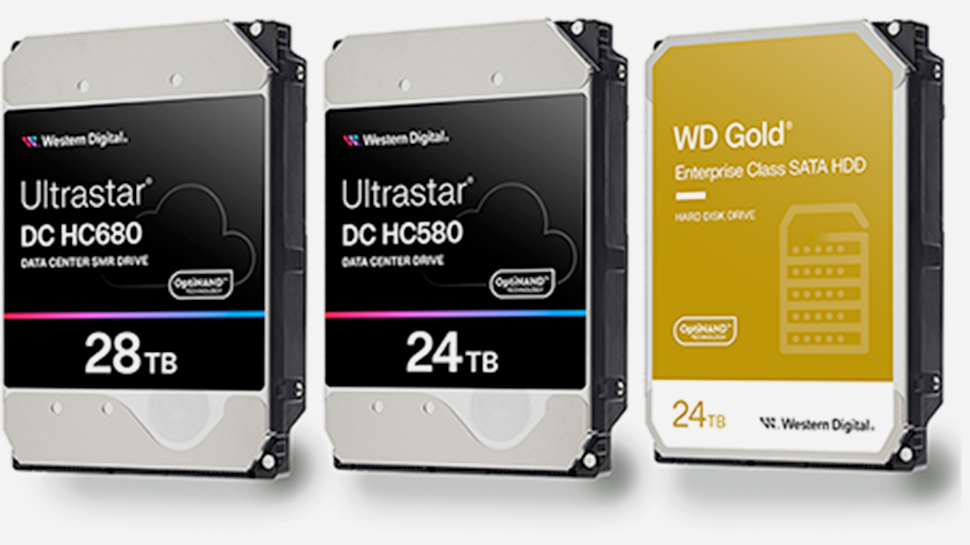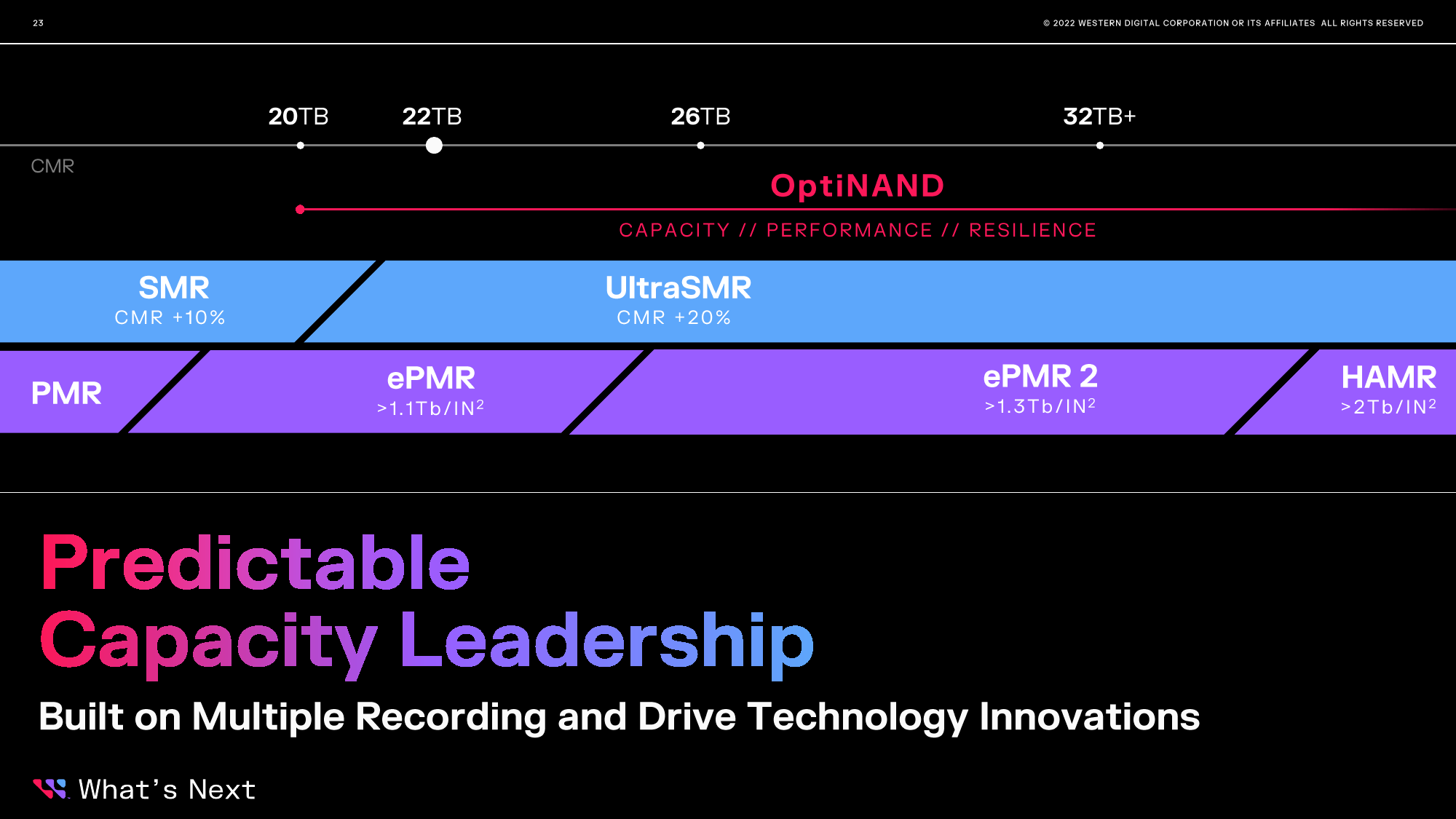WD's Latest Enterprise HDDs Store Up to 28TB, With Max Transfer Rates of 298 MB/s
Western Digital's Ultrastar and WD Gold drives address hyperscalers, CSPs, and enterprises.

Western Digital stated it had started volume shipment of its Ultrastar DC HC580 and WD Gold 24TB hard disk drives that use conventional magnetic recording, as well as volume production start of its Ultrastar DC HC680 28TB HDDs that rely on shingled magnetic recording. The drives are designed for a wide-variety of datacenter applications, including cloud, enterprise, exascale, and enterprise. The 24TB WD Gold drives will shortly hit retail.
The new HDDs are not only among the highest-capacity hard drives available today (or announced to date), but they are also very fast by HDD standards: the maximum data transfer rate is up to 298 MB/s (WD Gold, DC HC580), and their sustained data transfer rate is up to 265 MB/s (DC HC680). As far as power consumption is concerned, they are rated for 5.5W idle and 6.8W – 9.8W operational (50/50 read/write), which is more or less in line with their predecessors. Given the higher capacity of the new drives amid similar power consumption, their terabyte-per-Watt power efficiency is said to be 10% - 12% higher compared to previous-generation HDDs, which is good news for power-limited datacenters.
The new Ultrastar DC HC580 and WD Gold 24TB hard drives are based on the company's proven 10-disk enterprise-grade platform, with a 7200-RPM spindle speed that relies on energy-assisted perpendicular magnetic recording (ePMR) and features the company's proprietary OptiNAND enhancements to boost performance in real-world applications. The Ultrastar DC HC680 28TB uses shingled recording on some bands to further increase capacity of the drive, yet at the cost of the peculiarities associated with this recording method, such as very slow re-write speeds, and the necessity to optimize software for these HDDs.
"We are seeing strong momentum for Western Digital’s SMR HDDs and believe that SMR adoption will continue to grow as their new 28TB SMR HDD offers the next compelling TCO value proposition that cloud customers cannot ignore," said Ed Burns, research director of HDD and storage technologies at IDC.
Being datacenter HDDs, Western Digital's Ultrastar DC HC and WD Gold are rated for a 550TB annual workload and feature numerous enhancements to ensure that they work predictably and reliably in multi drive high-density storage environments, which includes top- and bottom-attached motors, rotational vibration sensors, enhanced read/write heads, and appropriate firmware.
The WD Gold 24 TB HDDs are shipping to the channel and interested parties among enterprises and SMBs. Cloud service providers, hyperscalers, and server OEMs are validating and qualifying the Ultrastar DC HC680 28TB and HC580 24TB HDDs with a SATA interface, so expect their deployment and availability in a few months. As for SAS versions of the Ultrastar DC HC680 and HC580 drives, expect their availability in the first quarter of 2024.
Get Tom's Hardware's best news and in-depth reviews, straight to your inbox.

Anton Shilov is a contributing writer at Tom’s Hardware. Over the past couple of decades, he has covered everything from CPUs and GPUs to supercomputers and from modern process technologies and latest fab tools to high-tech industry trends.
-
8086 298 MB/s is impressive for a spinning disc and makes me wonder when we will see SATA IV. That or future drives will probably come as Serial Attached SCSI.Reply -
Order 66 Reply
By the time SATA IV comes out, SATA as a standard will likely be obsolete. The SATA III 6GB/s standard has been around since 2009.8086 said:298 MB/s is impressive for a spinning disc and makes me wonder when we will see SATA IV. -
8086 Reply
Hard Disc Drives are going to be with us for a while and aren't going anywhere soon. As they are ideal for backups to SSDs and for long term bulk archival storage. Also data recovery on a dead HDD is much more reliable than on an dead SSD.Order 66 said:By the time SATA IV comes out, SATA as a standard will likely be obsolete. The SATA III 6GB/s standard has been around since 2009. -
Kamen Rider Blade Just move to SAS already.Reply
We need all MoBo's to start using U.3 as the standard connector and let us choose what to connect.
Each U.3 connector can split into 4x SATA, 4x SAS, or be a functional U.2 connector to a BackPlane allowing 4x PCIe lanes of your choice version.
Move all modern SSD's to 1.8" HDD form factor, and we're golden.
-
domih ReplyKamen Rider Blade said:Just move to SAS already.
We need all MoBo's to start using U.3 as the standard connector and let us choose what to connect.
Imagine every ATX MoBo with a row of U.3 Connectors along each edge.
Full size ATX MoBo's can have up to 11 U.3 ports
SSI (CEB, EEB, MEB) MoBo Formats with a dozen U.3 connectors.
Each U.3 connector can split into 4x SATA, 4x SAS, or be a functional U.2 connector to a BackPlane allowing 4x PCIe lanes of your choice version.
Move all modern SSD's to 1.8" HDD form factor, and we're golden.
This is not going to happen with desktop CPU/APU. 12 x U.3/U.2 = 48 PCIe lanes in addition to the existing ones (for GPU, a few NMVe, Chipset). INTEL and AMD are not going to throw their CPU market segmentation out of the window to allow a cornucopia of U.3/U.2 connectors on consumer boards. Add the cost of PCIe traces for mobos manufacturers. Unrealistic. With HEDT/Workstation/Server mobos, just use the numerous PCIe lanes with U.3/U.2 cards. Meaning: a lot of $$$. -
jeremyj_83 Reply
SATA III at 6Gbps is already able to handle double the speed that this drive achieves. Also SATA isn't widely used in data centers. HDDs are typically using the SAS III interface in the data center.8086 said:298 MB/s is impressive for a spinning disc and makes me wonder when we will see SATA IV. That or future drives will probably come as Serial Attached SCSI. -
USAFRet Reply
That's what the M.2 is supposed to be for.Kamen Rider Blade said:We need all MoBo's to start using U.3 as the standard connector and let us choose what to connect.
AKA NGFF - Next Gen Form Factor.
Storage, WiFi card, etc, etc.
I wager that...
The majority of people do not have more than a single drive.
Those that do, rarely need more than SATA III speed on the secondary SSDs.
And a NAS box can be VERY good for mass storage.
What you are asking for would be a very niche product. -
Kamen Rider Blade Reply
There are way's to get to that point with SouthBridge style chipsets fanning out as needed.domih said:This is not going to happen with desktop CPU/APU. 12 x U.3/U.2 = 48 PCIe lanes in addition to the existing ones (for GPU, a few NMVe, Chipset). INTEL and AMD are not going to throw their CPU market segmentation out of the window to allow a cornucopia of U.3/U.2 connectors on consumer boards. Add the cost of PCIe traces for mobos manufacturers. Unrealistic. With HEDT/Workstation/Server mobos, just use the numerous PCIe lanes with U.3/U.2 cards. Meaning: a lot of $$$.
Stop wasting mobo money on "Decorative Heatsinks" and funky color patterns on the MoBo, focus all the money on function on the MoBo.
M.2 is optimized for LapTop / Mobile world.USAFRet said:That's what the M.2 is supposed to be for.
AKA NGFF - Next Gen Form Factor.
Storage, WiFi card, etc, etc.
I wager that...
The majority of people do not have more than a single drive.
Those that do, rarely need more than SATA III speed on the secondary SSDs.
And a NAS box can be VERY good for mass storage.
What you are asking for would be a very niche product.
DeskTop doesn't need a fragile connector like M.2, that only hinders things.
U.2 / U.3 is th optimum DeskTop / Server environment connector.
A TRULY robust connector.
Your modern M.2 SSD needs 4x PCIe lanes just to operate.
Having a 4x PCIe lane based U.3 Connector just evens things out moving forward for nVME U.3 SSD's.
We'll have to agree to disagree on it being a niche product.
I believe in U.3 being the standard for DeskTop / Server environments and M.2 should be relegated to LapTop / Mobile / Space Constrained formats.
Such a fragile connection has no real useful place in the DeskTop / Enterprise world IMO. -
USAFRet Reply
They focus on what sells.Kamen Rider Blade said:Stop wasting mobo money on "Decorative Heatsinks" and funky color patterns on the MoBo, focus all the money on function on the MoBo.
(I'm not a fan of that decorative crap either) -
Kamen Rider Blade Reply
Long before "Pretty Gamer Aesthic RGB filled" MoBo's were the norm, MoBo's sold just fine with basic color schemes and it wasn't much of a issue.USAFRet said:They focus on what sells.
(I'm not a fan of that decorative crap either)
We need entire basic product lines like those back in every company.
